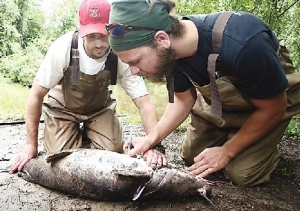Researchers study Little River migration
By Nick Hiltunen
Published in News on July 15, 2010 1:46 PM

News-Argus/MICHAEL BETTS
Joshua Raabe, left, a Ph.D. student at N.C. State, holds a fish tail as Donnie Danesi, a fishery technician, takes a reading from the fish while they study the fish migration on the Little River.
Donnie Danesi plunged a net into the Little River's waters and two huge catfish emerged wrapped in nylon, dripping and flailing their fins.
His friend and fellow graduate student Joshua Raabe followed quickly behind, helping to ease the fish to the ground.
The two researchers, affiliated with N.C. State University, had no interest in making a meal of the fish -- just putting a PIT tag inside them.
PIT is short for Passive Integrated Transponder, which is placed, after a small incision, inside the fish's body cavity near its stomach.
The system assigns a nine-digit number to the fish, presumably enough to provide unique identifiers for every one the men catch, a few miles from the "mouth" or confluence with the Neuse River. The device allows the scientists to track the fishes' movements, part of a project to learn more about the fish that inhabit the waters in and along the state's coast, sounds and rivers.
The researchers are most interested in the American shad, technically known as Alosa sapidissima, a fish that lives in sea water along the Atlantic coast, down to Northern Florida but that enters freshwater to spawn.
"This came from the ocean to spawn, so we call this an anadromous fish," Raabe said, explaining the term. "The adults come here to ... lay their eggs, and they'll live here until late summer or fall. Then they go back out to the ocean for about three or four years before they come back to the river."
Using the PIT tags provides the two N.C. State researchers with plenty of information, they said.
"We're trying to find out a lot of things," Raabe said. "We're trying to find out the population size ... how long they're in the river, where they're first showing up, and when they leave."
Other fish they are tracking included the gizzard and hickory shads and the flathead and blue and channel catfish.
Their doctoral research project began in 2007, in Pine Level, after a dam was removed near Lowell Mill.
The U.S. Fish and Wildlife Service became interested in studying the Little River and provided funding to N.C. State, which Raabe found out about and applied for.
Watching the river -- and the fish -- was what kept the men interested in their research.
"That's what excites me, when we catch huge fish, the big catfish. We've caught a couple of 40-pound-plus catfish," Danesi said. "I like seeing the dynamics of the river, too. Just a couple of days ago, this was a trickle, and now it's seven feet."
The flathead catfish is referred to as an "invasive species," which had probably come from the Neuse River, Raabe said.
"They can eat a lot of fish," the researcher said. "They're not very selective -- you saw how large their mouths are. They're kind of generalists -- they eat what they can get in their mouths."
Once the study is completed, the pair will try to publish scientific papers about the project, in the two major journals where fisheries research is published.
Raabe explained that besides invasive fish species, dams often provide research money because of the controversy they can create, like the Milburnie Dam in Raleigh, which once provided 3 million kilowatt hours of power to Wake County each year through a small hydroelectric plant.
"Dam removal is a very contentious issue. Most times, people don't want the dams to come out," Raabe said. "As biologists, we feel like we're restoring the fish, and protecting their populations."
